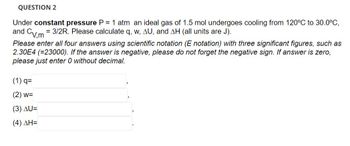
Introduction to Chemical Engineering Thermodynamics
8th Edition
ISBN: 9781259696527
Author: J.M. Smith Termodinamica en ingenieria quimica, Hendrick C Van Ness, Michael Abbott, Mark Swihart
Publisher: McGraw-Hill Education
expand_more
expand_more
format_list_bulleted
Question
thumb_up100%

Transcribed Image Text:QUESTION 2
Under constant pressure P = 1 atm an ideal gas of 1.5 mol undergoes cooling from 120°C to 30.0°C,
and = 3/2R. Please calculate q, w, AU, and AH (all units are J).
Cv.m
Please enter all four answers using scientific notation (E notation) with three significant figures, such as
2.30E4 (=23000). If the answer is negative, please do not forget the negative sign. If answer is zero,
please just enter 0 without decimal.
(1) q=
(2) w=
(3) AU=
(4) ΔΗ=
Expert Solution
arrow_forward
Step 1
Given Details:
At constant Pressure , Gas is being cooled
P=1 atm
no. of moles of gas ,n=1.5 mol
Initial Temperature, T1=1200C=120+273=393 K
Final Temperature, T2=30.00C=30+273=303 K
we need to determine the .
Step by stepSolved in 4 steps

Knowledge Booster
Similar questions
- 1. The Helmholtz function of a certain gas is given by (V – F (T,V) = –nRT |1+ ln v – nb)T? an? пф V where n is the number of moles of gas, T is the temperatures of the gas, V is the volume of the gas, and a, b, and o are constants. (a) Derive the equation of state, the entropy, and the internal energy of the gas. (b) Suppose that 100 moles of the gas expands from 2 m3 to 5 m³ at 280 K and that the constants have the values a = 0.364 J m3 mol-2, b = 4.27 × 10-5 m³ mol-1, and $ = 1.09 × 10-5 m³ K³/2 mol-1. Calculate: (i) AU. (ii) the maximum energy that can be made available for work due to the process.arrow_forward3. Potential density D is defined as the density of which dry air would attain if it were transformed reversibly and adiabatically from its existing conditions to a standard pressure po (usually 1000 mb). If the density and pressure of the air are p and p, respectively, it can be proven that the potential density can be expressed as, D = P(Pojev/cp P where cp and c, are the specific heats of air at constant pressure and constant volume, respectively. (a). Calculate the potential density of a quantity of air at a pressure of 600 mb and temperature -15 °C. (b) Show that 1 dD D dz == T (T₁-T) d where I'd is the dry adiabatic lapse rate, I the actual lapse rate of the atmosphere, and T the temperature at height z. [hint: cp - cv = R where R is the gas constant for dry air (R=287 Jdeg¹ kg-¹), cp=1004 Jdeg"¹ kg`¹, and cv=717 Jdeg`¹ kg-¹). (c) Show that the criteria for stable, neutral, and unstable conditions in the atmosphere are that the potential density decreases with height, is constant…arrow_forwardWhenever a substance is heated, its enthalpy increases, as suggested by the relation, ∆?=Cp∆?. However, the molar heat capacity itself is a function of temperature, and for N2 this function can be modeled as ?p(?)=? + ?? + c / T2 where a= 28.58 J/mol·K, b= 0.00377 J/mol·K2, and c= –5.0 x 104J·K/mol. (a) What does this formula for heat capacity predict for the value of ?p(?)at 300K? (b) Now, compute the enthalpy change associated with heating 0.62 moles of N2 from 300 to 600 K using the formula for ?p (?), and report the answer in J. (c) What is the difference between this value and one computed using the constant value for Cp at 300 K from part (a)? Report the absolute value of the difference in J.arrow_forward
- Answer only letter aarrow_forwardA group of students have injected 26 g of a gas into an evacuated, constant-volume container at50 C and atmospheric pressure. The students want to heat the gas at constant pressure byallowing some of the gas to escape during the heating. What mass of gas (in grams) must bereleased if the temperature is raised to 400 C?arrow_forwardmolar mass of ethanol: 46.094w = 0.645Tc = 513.9 KVc = 167cm^3/molTn = 351.4 K a.) Calculate the molar volume V (in cm3/mol) and compressibility factor Z of saturated liquid ethanol at T = 368 K.b.) Calculate the molar volume V (in cm3/mol) and compressibility factor Z of saturated vapor ethanol at T = 368 K.c.) Calculate the molar volume and compressibility factor Z of ethanol vapor at T = 462.5 K and P = 24.6 bar.arrow_forward
arrow_back_ios
arrow_forward_ios
Recommended textbooks for you
 Introduction to Chemical Engineering Thermodynami...Chemical EngineeringISBN:9781259696527Author:J.M. Smith Termodinamica en ingenieria quimica, Hendrick C Van Ness, Michael Abbott, Mark SwihartPublisher:McGraw-Hill Education
Introduction to Chemical Engineering Thermodynami...Chemical EngineeringISBN:9781259696527Author:J.M. Smith Termodinamica en ingenieria quimica, Hendrick C Van Ness, Michael Abbott, Mark SwihartPublisher:McGraw-Hill Education Elementary Principles of Chemical Processes, Bind...Chemical EngineeringISBN:9781118431221Author:Richard M. Felder, Ronald W. Rousseau, Lisa G. BullardPublisher:WILEY
Elementary Principles of Chemical Processes, Bind...Chemical EngineeringISBN:9781118431221Author:Richard M. Felder, Ronald W. Rousseau, Lisa G. BullardPublisher:WILEY Elements of Chemical Reaction Engineering (5th Ed...Chemical EngineeringISBN:9780133887518Author:H. Scott FoglerPublisher:Prentice Hall
Elements of Chemical Reaction Engineering (5th Ed...Chemical EngineeringISBN:9780133887518Author:H. Scott FoglerPublisher:Prentice Hall
 Industrial Plastics: Theory and ApplicationsChemical EngineeringISBN:9781285061238Author:Lokensgard, ErikPublisher:Delmar Cengage Learning
Industrial Plastics: Theory and ApplicationsChemical EngineeringISBN:9781285061238Author:Lokensgard, ErikPublisher:Delmar Cengage Learning Unit Operations of Chemical EngineeringChemical EngineeringISBN:9780072848236Author:Warren McCabe, Julian C. Smith, Peter HarriottPublisher:McGraw-Hill Companies, The
Unit Operations of Chemical EngineeringChemical EngineeringISBN:9780072848236Author:Warren McCabe, Julian C. Smith, Peter HarriottPublisher:McGraw-Hill Companies, The

Introduction to Chemical Engineering Thermodynami...
Chemical Engineering
ISBN:9781259696527
Author:J.M. Smith Termodinamica en ingenieria quimica, Hendrick C Van Ness, Michael Abbott, Mark Swihart
Publisher:McGraw-Hill Education

Elementary Principles of Chemical Processes, Bind...
Chemical Engineering
ISBN:9781118431221
Author:Richard M. Felder, Ronald W. Rousseau, Lisa G. Bullard
Publisher:WILEY

Elements of Chemical Reaction Engineering (5th Ed...
Chemical Engineering
ISBN:9780133887518
Author:H. Scott Fogler
Publisher:Prentice Hall


Industrial Plastics: Theory and Applications
Chemical Engineering
ISBN:9781285061238
Author:Lokensgard, Erik
Publisher:Delmar Cengage Learning

Unit Operations of Chemical Engineering
Chemical Engineering
ISBN:9780072848236
Author:Warren McCabe, Julian C. Smith, Peter Harriott
Publisher:McGraw-Hill Companies, The